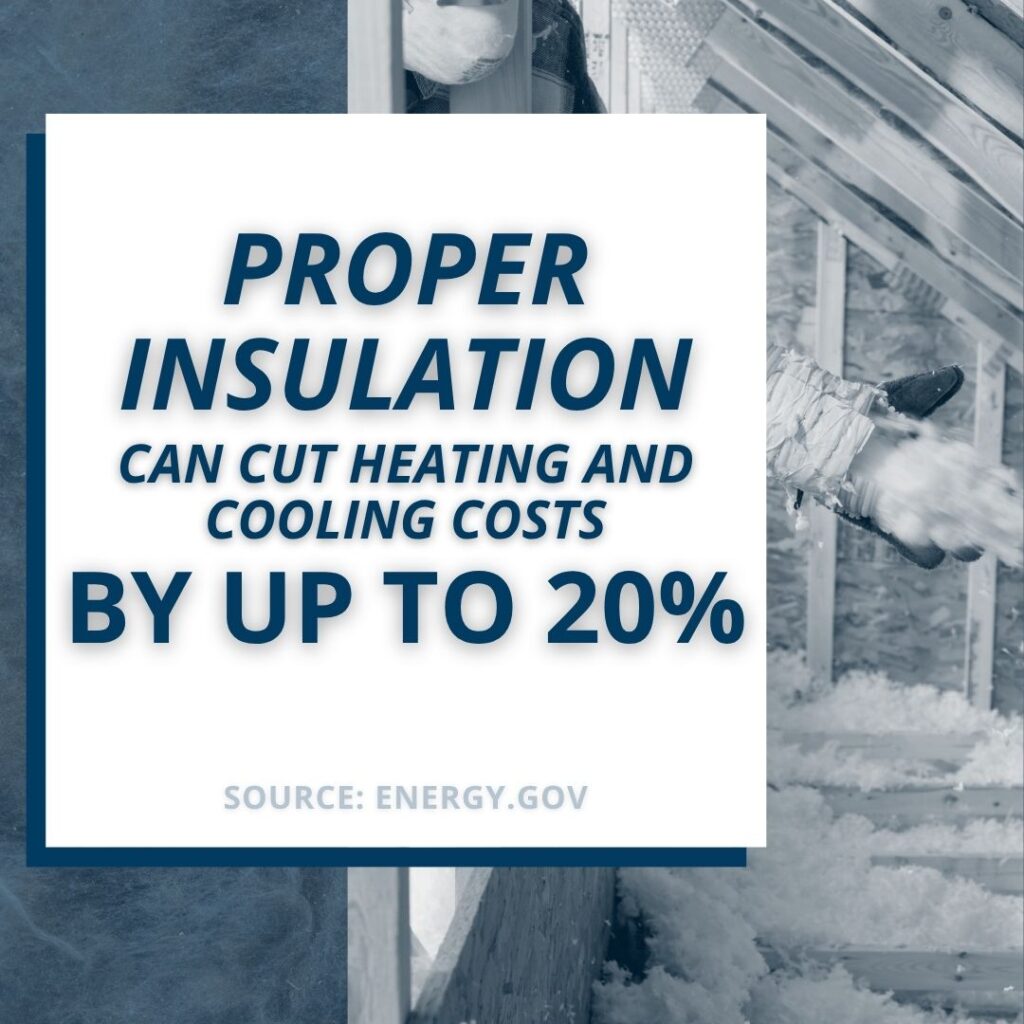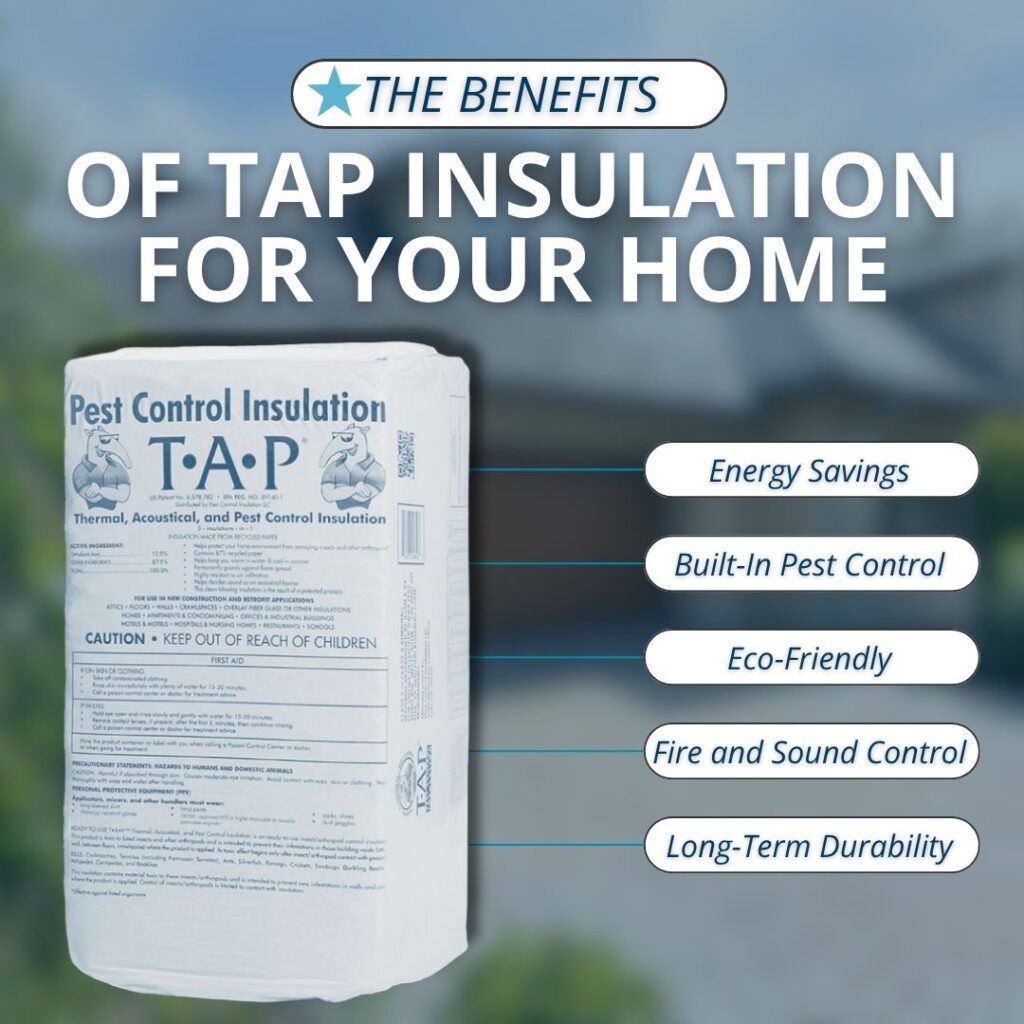If your attic still has old fiberglass or loose-fill insulation, it might be costing you more than you realize. Traditional insulation helps with temperature control, but it does little to stop bugs, rodents, and moisture from sneaking in. That’s why more Charleston-area homeowners are turning to TAP insulation, a unique product that improves comfort, lowers energy bills, and repels common household pests.
In this guide, we’ll break down what TAP insulation is, how it works, and why upgrading can protect both your wallet and your home for years to come.
What Is TAP Insulation?
TAP (“Thermal, Acoustical, Pest-resistant”) insulation is an eco-friendly material made primarily from recycled paper that’s treated with a natural pest-control agent, boric acid.
Once blown into attics or wall cavities, it creates a thick, seamless layer that traps heat in winter, keeps it out in summer, and deters insects like ants, roaches, and silverfish.
Unlike rolls or batts, TAP insulation is loose-fill and settles into tight corners around wires, pipes, and framing. This complete coverage minimizes gaps that typically waste energy and allow pests to hide.
The U.S. Department of Energy notes that proper insulation can cut heating and cooling costs by up to 20 percent. TAP insulation adds pest protection to those savings, making it one of the most practical upgrades for homeowners in humid climates like South Carolina.
How TAP Insulation Works
TAP insulation functions on two key principles: energy efficiency and pest prevention.
- Thermal Barrier Performance
TAP uses densely packed cellulose fibers to slow the transfer of heat. This creates a more stable indoor temperature throughout the year, reducing strain on HVAC systems. - Sound Absorption
Because the fibers are loosely packed, TAP insulation also absorbs sound waves, helping reduce outdoor noise and echo between rooms. - Built-in Pest Resistance
The borate compound infused into the cellulose is harmless to people and pets but lethal to insects that try to live within the material. When pests come into contact with it, the compound affects their digestive and reproductive systems, eliminating colonies over time.
The result is a quiet, comfortable, pest-resistant home with improved air quality and lower utility costs.

Why South Carolina Homes Need Better Insulation
Our coastal climate brings humidity, heat, and frequent storms, all of which challenge standard insulation materials. Fiberglass and foam boards can lose effectiveness when they absorb moisture, creating an ideal environment for pests and mold.
Common local problems TAP insulation helps prevent:
- Humidity and moisture retention that cause insulation to clump or collapse
- Attic pests such as roaches, ants, and silverfish that nest in fiberglass
- Rodent damage to ductwork and wiring
- Energy loss from drafty attics in older homes
Because TAP insulation fills every void and naturally resists insects, it performs better under these coastal conditions than traditional options.
Key Benefits of TAP Insulation
TAP insulation stands out for the way it performs over time. Here are some of the biggest benefits homeowners notice after installation.
1. Energy Savings Year-Round
Charleston homeowners often see noticeable improvements in comfort and efficiency after upgrading. According to the EPA’s Energy Star program, sealing air leaks and adding insulation can save an average of 15 percent on heating and cooling costs. TAP insulation achieves that by reducing heat transfer and maintaining a consistent indoor temperature.
2. Built-In Pest Control
The borate compound inside TAP creates a protective barrier against roaches, ants, beetles, and other insects. If they try to burrow into the insulation, they ingest trace amounts of borate dust, which prevents them from feeding and breeding. This makes the material a long-term, maintenance-free addition to your pest control plan.
3. Environmentally Friendly
TAP insulation is made from approximately 80 percent recycled paper, diverting tons of waste from landfills each year. Because it uses minimal energy to manufacture and has no off-gassing, it’s a safer choice for families and the environment.
4. Fire Resistance and Sound Control
Boric acid also acts as a flame retardant and sound dampener. Homes with TAP insulation stay quieter and gain extra fire safety without needing additional chemical treatments.
5. Long-Term Durability
Traditional fiberglass can lose effectiveness over time as it compresses or gathers moisture. TAP insulation retains its R-value and pest-resistant properties for decades when installed properly by a certified technician.
How TAP Insulation Compares to Traditional Options
|
Feature |
TAP Insulation |
Fiberglass Batts |
Spray Foam |
|
Pest Resistance |
Excellent |
None |
Moderate |
|
Sound Proofing |
High |
Low |
Medium |
|
Eco-Friendliness |
80 % recycled content |
Synthetic materials |
Low VOC but non-recycled |
|
Moisture Tolerance |
Good |
Poor |
Excellent |
|
Average Lifespan |
20–30 years |
10–15 years |
20 + years |
|
Cost Efficiency |
Moderate install, high savings |
Low initial, lower savings |
High initial cost |
While spray foam has its place, TAP offers a balanced blend of performance, price, and pest protection that fits most South Carolina homes perfectly.
When to Consider Upgrading Your Insulation
Many homeowners don’t realize their attic insulation is underperforming until they notice signs of energy loss or pest issues.
Common indicators include:
- Uneven temperatures between rooms
- High utility bills despite seasonal maintenance
- Visible gaps or discoloration in attic insulation
- Noise from pests or evidence of droppings in the attic
- Excess dust or drafts around ceiling fixtures
If you notice these signs, Precision Pest & Home Services can inspect your attic and recommend the right insulation upgrade based on your home’s age and structure.
Professional Installation Process
Precision’s certified technicians follow a careful process to ensure quality results and maximum energy savings:
- Assessment: They inspect your attic for current R-value, air leaks, and signs of pests or moisture.
- Preparation: Old insulation is removed if damaged or contaminated to ensure clean application.
- Air Sealing: Gaps around vents and light fixtures are sealed to prevent heat transfer.
- Installation: TAP insulation is blown evenly across the attic floor to create a thick, uniform layer.
- Final Inspection: Technicians verify coverage depth and check for consistent distribution to meet energy standards.
Professional installation ensures the material performs to its rated R-value and that pest resistance is even throughout.

How TAP Insulation Supports Pest Management
For Charleston homeowners, one of the biggest advantages of TAP insulation is its role in long-term pest control. It acts as both a physical and chemical barrier against insects that typically enter through the attic.
TAP helps defend against:
- Ants and carpenter bees
- Silverfish and booklice
- Roaches and earwigs
- Beetles and fleas
Because the borate compound is evenly distributed through the material, its effectiveness does not fade or require retreatment. This makes it a perfect complement to Precision’s integrated pest control programs.
Safety and Environmental Considerations
Homeowners often ask whether borate-treated insulation is safe for children and pets. The answer is yes. Borates have low toxicity for humans and mammals but are highly effective against insects. They have been used in pest control products for decades with a strong safety record.
TAP insulation is also non-corrosive, non-combustible, and resists mold growth when kept dry. It contains no fiberglass particles, so it won’t cause itching or respiratory irritation during installation or repairs.
Cost and Long-Term Value
The initial cost of TAP insulation is competitive with other premium materials, but its benefits often pay for themselves within a few years through energy savings and reduced pest treatments.
Estimated returns for homeowners:
- 10–20 percent lower energy bills each year
- Fewer service calls for attic pests and repairs
- Increased home comfort and noise control
Because the material does not degrade quickly, TAP insulation can continue to perform for 20 years or more with minimal maintenance.
Other Related Questions Homeowners Ask
How long does TAP insulation last?
When installed correctly, it can maintain its effectiveness for 20–30 years without replacement.
Will TAP insulation stop rodents?
While borates target insects, the dense layer makes nesting less appealing for rodents. Precision can pair installation with rodent exclusion for complete protection.
How does insulation tie into pest control and crawl space services?
Insulation isn’t just about energy. The right insulation layer also protects from moisture and pests. Precision offers crawl space encapsulation and moisture remediation alongside insulation upgrades so you get full protection.
When to Call a Professional
DIY insulation may seem simple, but installing TAP properly requires special equipment and training. An improper application can lead to uneven coverage and reduced R-value.
If your home feels drafty or you suspect pests in the attic, schedule an inspection with Precision Pest & Home Services. Their team is certified to install TAP insulation safely and efficiently throughout Charleston and the surrounding areas.
They can evaluate your current insulation, recommend the right R-value for local building codes, and install a solution that keeps your home comfortable year-round.
Conclusion
TAP insulation is more than a comfort upgrade; it’s a smart investment in your home’s energy efficiency and pest protection. By combining thermal performance with built-in insect control, it solves two of Charleston’s most common home maintenance problems at once.
If you’re ready to save energy and create a cleaner, pest-free home, contact Precision Pest & Home Services today. Our team will assess your attic and help you decide if this eco-friendly upgrade is right for you.


